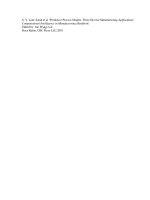Computational Intelligence In Manufacturing Handbook P4
Bạn đang xem bản rút gọn của tài liệu. Xem và tải ngay bản đầy đủ của tài liệu tại đây (292.99 KB, 23 trang )
Suresh, Nallan C. "Neural Network Applications for Group Technology and Cellular Manufacturing"
Computational Intelligence in Manufacturing Handbook
Edited by Jun Wang et al
Boca Raton: CRC Press LLC,2001
©2001 CRC Press LLC
4
Neural Network
Applications for
Group Technology
and Cellular
Manufacturing
4.1 Introduction
4.2 Artificial Neural Networks
4.3 A Taxonomy of Neural Network Application
for GT/CM
4.4 Conclusions
4.1 Introduction
Recognizing the potential of artificial neural networks (ANNs) for pattern recognition, researchers first
began to apply neural networks for group technology (GT) applications in the late 1980s and early 1990s.
After a decade of effort, neural networks have emerged as an important and viable means for pattern
classification for the application of GT and design of cellular manufacturing (CM) systems. ANNs also
hold considerable promise, in general, for reducing complexity in logistics, and for streamlining and
synergistic regrouping of many operations in the supply chain. This chapter provides a summary of
neural network applications developed for group technology and cellular manufacturing.
Group technology has been defined to be, in essence, a broad philosophy that is aimed at (1) identi-
fication of part families, based on similarities in design and/or manufacturing features, and (2) systematic
exploitation of these similarities in every phase of manufacturing operation [Burbidge, 1963; Suresh and
Kay, 1998].
Figure 4.1 provides an overview of various elements of group technology and cellular manufacturing.
It may be seen that the identification of part families forms the first step in GT/CM. The formation of
part families enables the realization of many synergistic benefits in the design stage, process planning
stage, integration of design and process planning functions, production stage, and in other stages down-
stream.
In the design stage, classifying parts into families and creating a database that is easily accessed during
design results in:
• Easy retrieval of existing designs on the basis of needed design attributes
• Avoidance of “reinvention of the wheel” when designing new parts
Nallan C. Suresh
State University of New York
at Buffalo
University of Groningen
©2001 CRC Press LLC
• Countering proliferation of new part designs
• Reduction in developmental lead times and costs
• Better data management, and other important benefits.
Likewise, in the downstream, production stage, part families and their machine requirements form
the basis for the creation of manufacturing cells. Each cell is dedicated to manufacturing one or more
part families. The potential benefits from (properly designed) cellular manufacturing systems include:
• Reduced manufacturing lead times and work-in-process inventories
• Reduced material handling
• Simplified production planning and control
• Greater customer orientation
• Reduced setup times due to similarity of tool requirements for parts within each family
• Increased capacity and flexibility due to reduction of setup times, etc.
For implementing GT and designing cells, early approaches relied on
classification and coding systems
,
based on the premise that part families with similar designs will eventually lead to identification of cells.
Classification and coding systems involve introducing codes for various design and/or manufacturing
attributes. A database is created and accessed through these “GT codes.” This offers several advantages,
such as design rationalization and variety reduction and better data management, as mentioned above.
But the codification activity involves an exhaustive scrutiny of design data, possible errors in coding, and
the necessity for frequent recoding. The need for classification and coding systems has also been on the
decline due to advances in database technologies, especially the advent of relational databases.
Therefore, in recent years, cell design methods have bypassed the cumbersome codification exercise.
They have relied more on a direct analysis of part routings, to identify parts with similar routings and
machine requirements. Part families and machine families are identified simultaneously by manipulating
part-machine incidence matrices.
FIGURE 4.1
Elements of GT/CM. (From Suresh, N.C. and Kay, J.M. (Eds.), 1998,
Group Technology and Cellular
Manufacturing: State-of-the-Art Synthesis of Research and Practice,
Kluwer Academic Publishers, Boston. With
permission.)
Part Family
Identification
Engineering
Design
Process
Planning
Production:
Cellular
Manufacturing
Production
Planning &
Control
Other
Functions
GROUP TECHNOLOGY &
CELLULAR MANUFACTURING
©2001 CRC Press LLC
The application of neural networks for GT/CM has undergone a similar evolution. As described below,
early efforts for utilizing ANNs for GT/CM were devoted to identification of part families based on design
and manufacturing process features, while much of the later efforts have been devoted to the use of
neural networks for part-machine grouping based on direct analysis of part routings.
The objective of this chapter is to provide a systematic, and state-of-the-art overview of various neural
network architectures developed to support group technology applications. A taxonomy of this literature
is provided, in addition to a summary of the implementation requirements, pros and cons, computational
performance and application domain for various neural network architectures.
4.2 Artificial Neural Networks
Artificial neural networks have emerged in recent years as a major means for
pattern recognition,
and it
is this particular capability that has made ANNs a useful addition to the tools and techniques applicable
for group technology and design of cellular manufacturing systems.
ANNs are “massively parallel, interconnected networks of simple processing units (neurons), and their
hierarchical organizations and connections which interact with objects in the real world along the lines
of biological nervous systems” [Kohonen, 1984]. The basic elements of a neural network are the processing
units (neurons), which are the nodes in the network, and their connections and connection weights.
The operation of a neural network is specified by such factors as the propagation rule, activation/trans-
fer function, and learning rule. The neurons receive weighted input values, which are combined into a
single value. This weighted input is transformed into an output value through a nonlinear
activation
function
. The activation function could be a hard limiter, sigmoidal nonlinearity or a threshold logic
limit. This neuro-computing process is illustrated in Figure 4.2.
FIGURE 4.2
Neural computation.
x
1
Output of neuron j: y
j
= f
a
(S
j
),
where f
a
is activation function and
S
j
= ( x
1
w
1j
+ . . + x
n
w
nj
)
j
x
3
x
2
x
n-1
x
n
..
w
1j
w
2j
w
3j
w
n-1,j
w
nj
y
j
Input Vector
©2001 CRC Press LLC
In a neural network, the nodes respond to information converging from other layers via the connec-
tions. The connection weights represent almost all the stored information in a network, and these weights
are updated in response to new information entering the system. The learning rule specifies how the
weights are to be updated in response to new information. For further details on basics of neural networks,
readers are referred to works such as Wasserman [1989] and McClelland and Rumelhart [1988]. It must
be stressed that all the above networks, though based on massive parallelism, are all still simulated using
conventional, sequential computing, awaiting the development of neuro-computing hardware in the
future.
Among the many properties of ANNs, their pattern recognition capability is of foremost relevance in
the context of GT/CM. Unlike traditional artificial intelligence (AI) methods, employing logic and rule-
driven procedures for pattern recognition, ANNs are adaptive devices that recognize patterns more
through experience. Neural networks also have the ability to learn complex patterns and to generalize
the learned information faster. They have the ability to work with incomplete information. Compared
to rule-driven expert systems, neural networks are applicable when [Burke, 1991]
• The rules underlying decisions are not well understood
• Numerous examples of decisions are available
• A large number of attributes describe the inputs.
In contrast to traditional, statistical clustering, ANNs offer a powerful classification option when
[Burke, 1991]
• The input generating distribution is unknown and probably non-Gaussian
• Estimating statistical parameters can be expensive and/or time consuming
• Nonlinear relationships, and noise and outliers in the data may exist
• On-line decision making is required.
Neural networks are characterized by parallelism: instead of serially computing the most likely classi-
fication, the inputs, outputs, as well as internal computations are performed in parallel. The internal
parameters (weight vectors) are typically adapted or trained during use. In addition to this ability to
adapt and continue learning, neural network classifiers are also nonparametric and make weaker assump-
tions regarding underlying distributions.
Based on the direction of signal flow, two types of neural networks can be identified. The first type
of architecture is the
feedforward
network, in which there is unidirectional signal flow from the input
layers, via intermediate layers, to an output stage. In the
feedback
network, signals may flow from the
output of any neuron to the input of any neuron.
Neural networks are also classified on the basis of the type of learning adopted. In
supervised learning,
the network is trained, so that the inputs, as well as information indicating correct outputs, are presented
to the network. The network is also “programmed” to know the procedure to be applied to adjust the
weights. Thus, the network has the means to determine whether its output was correct and the means
to apply the learning law to adjust its weights in response to the resulting errors. The weights are modified
on the basis of the errors between desired and actual outputs in an iterative fashion.
In
unsupervised learning,
the network has no knowledge of what the correct outputs should be, since
side information is not provided to convey the correct answers. As a series of input vectors are applied,
the network clusters the input vectors into distinct classes depending on the similarities. An
exemplar
vector
(representative vector) is used to represent each class. The exemplar vector, after being created, is
also updated in response to a new input that has been found to be similar to the exemplar. As all inputs
are fed to the network, several exemplars are created, each one representing one cluster of vectors.
Combined unsupervised–supervised learning
first uses unsupervised learning to form clusters. Labels are
then assigned to the clusters identified and a supervised training follows.
Many types of neural network models have been developed over the years. The taxonomy of neural
network models proposed by Lippmann [1987] is widely used in the literature. This classifies ANNs first
©2001 CRC Press LLC
into those that accept binary-valued inputs and those accepting continuous-valued inputs. Secondly,
these are classified on the basis of whether they are based on supervised or unsupervised training. These
are further refined into six basic types of classifiers. However, within ART networks, with the emergence
of Fuzzy ART, which accepts continuous values, and other developments, this taxonomy requires revision.
4.3 A Taxonomy of Neural Network Application for GT/CM
The application of neural networks for GT/CM can be classified under several major application areas
along with the types of neural network used within each context. Reviewing the literature, three broad
application areas for neural networks can be seen in the context of group technology: (1) pattern
classification (part family formation) based on design and manufacturing features; (2) pattern classifi-
cation (part-and-machine family formation) from part–machine incidence matrices; and (3) other clas-
sification applications such as part and tool grouping, which are also useful in the context of flexible
manufacturing systems (FMS).
Within each of the above application areas, a wide range of networks have been applied, and we classify
them into the schemes shown in Table 4.1 and Table 4.2. A taxonomy of neural networks and fuzzy set
methods for part–machine grouping was also provided by Venugopal [1998]. The sections below are
based on the three broad application areas mentioned above.
4.3.1 Pattern Classification Based on Design and Manufacturing Features
The application of neural networks based on design and manufacturing features can be placed within
the contexts of part family identification, engineering design, and process planning blocks shown in
Figure 4.1. Based on a review of ANNs developed for these application areas, they may be classified
further into four subcategories. These include the use of neural networks primarily to
1. Facilitate classification and coding activity
2. Retrieve existing designs based on features required for a new part
3. Form part families based on design and/or manufacturing features
4. Support GT-based design and process planning functions.
TABLE 4.1
Pattern Classification Based on Design and Manufacturing Features
Supervised Learning
Unsupervised Learning
Application Area
Back-Propagation
Hopfield
Competitive Learning
Interactive Activation
Kohonen’s SOFM
ART1 and Variants
Fuzzy ART
Facilitate Classification and Coding
Kaparthi & Suresh [1991]
•
D
esign Retrieval Systems
Kamarthi et al. [1990]
Venugopal & Narendran [1992]
•
•
Part Family Formation
Kao & Moon [1990, 1991]
Moon & Roy [1992]
Chakraborty & Roy [1993]
Liao & Lee [1994]
Chung & Kusiak [1994]
•
•
•
•
•
Support GT-Based Design Process
Kusiak & Lee [1996] •
©2001 CRC Press LLC
Traditionally, the identification of part families for group technology has been via a classification and
coding system which, as stated earlier, has generally given way to more direct methods that analyze process
plans and routings to identify part families. Neural network applications for GT/CM have undergone a
similar evolution. Table 4.1 presents a classification of the literature based on the above four categories.
Table 4.1 also categorizes them under various supervised and unsupervised network categories. As seen
in the table, most of the methods developed for this problem are based on supervised neural networks,
especially the feedforward (back-propagation) network.
The work of Kaparthi and Suresh [1991] belongs to the first category. This study proposed a neural
network system for shape-based classification and coding of rotational parts. Given the fact that classi-
fication and coding is a time-consuming and error-prone activity, a back-propagation network was
designed to generate shape-based codes, for the Opitz coding system, directly from bitmaps of part
drawings. The network is first trained, using selected part samples, to generate geometry-related codes
of the Opitz coding system. The examples demonstrated pertained to rotational parts, but extension to
TABLE 4.2
Pattern Classification Based on Part–Machine/Tool Matrix Elements
Supervised Learning
Unsupervised Learning
Application Area
Back-Propagation
Hopfield
Competitive Learning
Interactive Activation
Kohonen’s SOFM
ART1 and Variants
Fuzzy ART
Other Models
Block Diagonalization
Jamal [1993] •
Malave & Ramachandran [1991]
Venugopal & Narendran [1992a, 1994]
Chu [1993]
Malakooti & Tang [1995]
•
•
•
•
••
Moon [1990a, 1990b]
Moon & Chi [1992]
Currie [1992]
•
•
•
Lee et al. [1992]
Kiang, Hamu & Tam [1992]
Kiang, Kulkarni & Tam [1995]
Kulkarni & Kiang [1995]
•
•
•
•
Kusiak & Chung [1991]
Dagli & Huggahalli [1991]
Kaparthi & Suresh [1992, 1994]
Dagli & Sen [1992]
Kaparthi, Cerveny & Suresh [1993]
Liao & Chen [1993]
Dagli & Huggahalli [1995]
Chen & Chung [1995]
•
•
•
•
•
•
•
•
Burke & Kamal [1992, 1995]
Suresh & Kaparthi [1994]
Kaparthi & Suresh [1994]
Kamal & Burke [1996]
•
•
•
•
Capacitated Cell Formation
Rao and Gu [1994, 1995]
Suresh, Slomp & Kaparthi [1995]
•
•
Sequence-Dependent Clustering
Suresh, Slomp & Kaparthi [1999]
•
Part-Tool Matrix Elements
Arizono et al. [1995]
•
©2001 CRC Press LLC
prismatic parts was seen to be feasible. The network was viewed as an element of a computer-aided design
(CAD) system, serving to facilitate design procedures in general, and to retrieve existing designs and
foster standardization and variety reduction among parts.
Works such as Kamarthi et al. [1990] and Venugopal and Narendran [1992b] have addressed the
problem of design retrieval. Kamarthi et al. [1990] used the feedforward neural network model trained
with the back-propagation algorithm. It was shown that neural networks can be effectively utilized for
design retrieval even in the presence of incomplete or inexact design data. Venugopal and Narendran
[1992b] applied a Hopfield network to model design retrieval systems in terms of a human associative
memory process. Test cases involved both rotational and nonrotational parts.
The third category of methods involve the use of neural networks for forming part families based on
design and/or manufacturing features. Instead of resorting to the laborious part classification and coding
activity, these methods are aimed at clustering directly from part features presented to the networks.
Almost all these methods have utilized the three-layer feedforward network, with part features forming
the input. The network classifies the presented features into families and helps assign new parts to specific
families. The basic mode of operation is as follows.
First, design features are identified to cover design attributes of all the parts. Features are design
primitives or low-level designs, along with their attributes, qualifiers and restrictions which affect func-
tionality or manufacturability. Features can be described by form (size and shape), precision (tolerances
and finish) or material type. The feature vector can either be extracted from a CAD system or codified
manually based on part features. Almost all the works have considered the feature vectors as binary-
valued inputs (with an activation value of one if a specified feature is present and a value of zero
otherwise). However, future implementations are expected to utilize continuous-valued inputs.
The neural network is constructed as shown in Figure 4.3. The processing units (neurons) in the input
layer correspond to all the part features. The number of neurons in the input layer equals the number
of features codified. The output layer neurons represent the part families identified. The number of
neurons in the output layer equals the expected (or desired) number of families. The middle, hidden
FIGURE 4.3
Feedforward network.
Output layer
Middle (hidden) layer
Family 1
Input Patterns: Feature Vector
Family 3Family 2
Input layer
©2001 CRC Press LLC
layer provides a nonlinear mapping between the features and the part families. The number of neurons
required for the middle layer is normally determined through trial and error. Neural networks are at
times criticized for the arbitrariness, or absence of guidelines for the number of neurons to be used in
middle layers.
The input binary-valued vector is multiplied by the connection weight
w
ij
,
and all the weighted inputs
are summed and processed by an activation function
f
′
ι
(net
pi
). The output value of the activation function
becomes the input for a neuron in the next layer. For more details on the basic operation of three-layer
feedforward networks and back-propagation learning rule, the reader is referred to standard works of
Wasserman [1989] and McClelland and Rumelhart [1988].
The net input, net
pi
, to a neuron
i
, from a feature pattern
p
, is calculated as
net
pi
=
Σ
j
w
ij
a
pj
Equation (4.1)
a
pi
=
f
′
ι
(net
pi
) = 1/[1 + exp(-net
pi
)] Equation (4.2)
where
a
pi
is the activation value of processing unit
p
from pattern
p
. This is applied for processing units
in the middle layer. The net input is thus a weighted sum of the activation values of the connected input
units (plus a bias value, if included). The connection weights are assigned randomly in the beginning
and are modified using the equation
∆
w
ij
=
ε
δ
pi
a
pj
Equation (4.3)
These activation values are in turn used to calculate the net inputs and activation values of the processing
units in the output layer using Equations 4.1 and 4.2. Next, the activation values of the output units are
compared with desired target values during training. The discrepancy between the two is propagated
backwards using
δ
pi
= (t
pi
– a
pi
)
f
′
i
(net
pi
) Equation (4.4)
For the middle layer, the following equation is used to compute discrepancy:
δ
pi
=
f
′
ι
(net
pi
)
Σ
j
δ
pk
w
ki
Equation (4.5)
With these discrepancies, the weights are adjusted using Equation 4.3. Based on the above procedure,
Kao and Moon [1991] presented a four-phased approach for forming part families, involving (1) seeding
phase, (2) mapping phase, (3) training phase, and (4) assigning phase. In the seeding phase, a few very
distinct parts are chosen from the part domain to identify basic families. In the mapping phase, these
parts are coded based on their features. The network is trained in the training phase utilizing the back-
propagation rule. In the assigning phase, the network compares a presented part with those with which
it was trained. If the new part does not belong to any assigned family, a new family is identified.
Moon and Roy [1992] developed a feature-based solid modelling scheme for part representations.
Again, part features are input to a three-layer feedforward network and classified into part families by
the output layer. The training proceeds along conventional lines using predetermined samples of parts
and their features. The network can then be used to classify new parts. The new part needs to be
represented as a solid model, and the feature-extraction module presents the features to the input layer
of the neural network. The system was found to result in fast and consistent responses. This basic
procedure is followed in other works shown in Table 4.1.
A fourth application area of neural networks is to support engineering functions more generally.
Several researchers have approached the design process in fundamental terms as a mapping activity, from
a function space, to a structure space and eventually to a physical space. The design activity is based on
an associative memory paradigm for which neural networks are ideally suited. Works such as Coyne and









